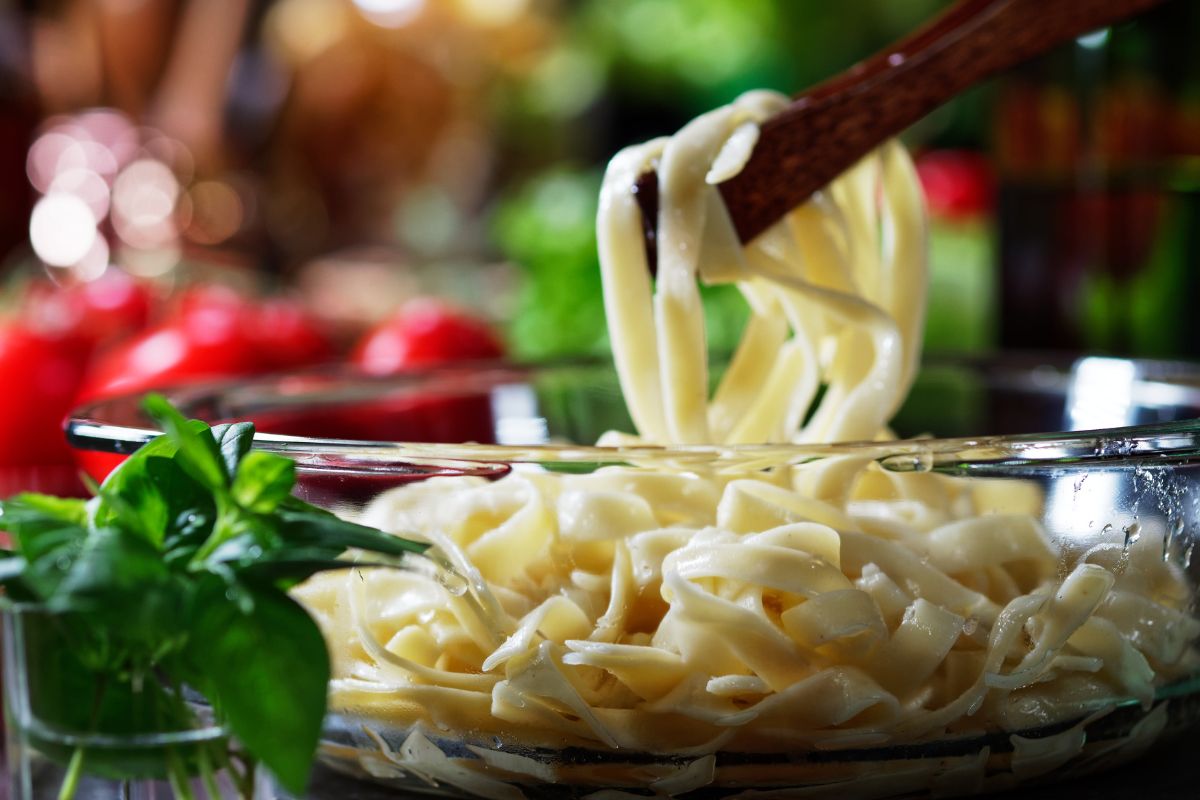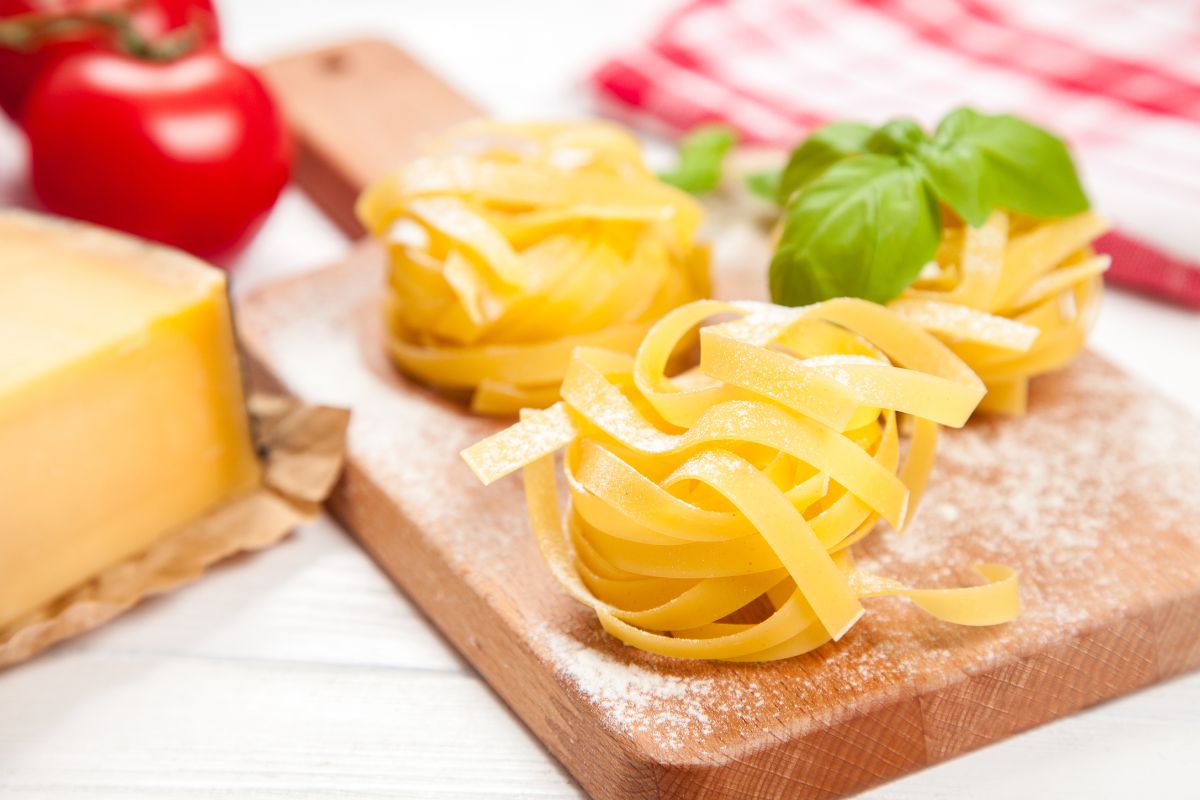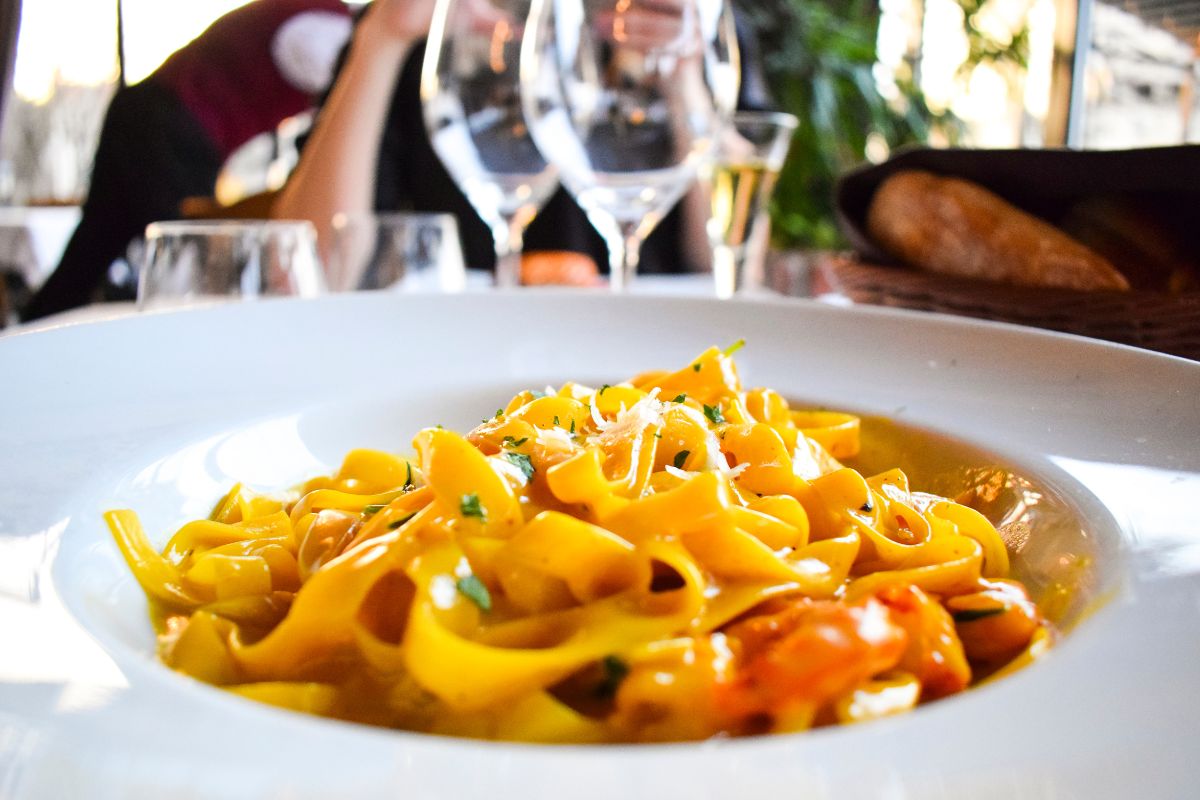The Different Pasta Types
In this article, we delve into the delightful world of tagliatelle vs. fettuccine, exploring their origins, differences, and the diverse culinary experiences they offer. When it comes to classic Italian pasta, few dishes capture the essence of culinary artistry, quite like tagliatelle and fettuccine.
These types of pasta noodles are popular worldwide for their delicate texture and ability to perfectly complement a variety of sauces. They possess subtle differences that set them apart.

What is Tagliatelle?
Tagliatelle is a pasta originating in Italy’s Emilia Romagna and Marche regions. Its name derives from the Italian word “tagliere,” meaning “to cut,” as they traditionally make it by hand-cutting the pasta dough into long, flat ribbons.
One of the most famous and traditional pairings for tagliatelle is Ragú alla Bolognese, the original version of what Americans call bolognese sauce. The slightly textured, flat thick spaghetti noodles are ideal for grasping and holding onto the rich, meaty ragú, providing a delightful springy bite and texture.
In the Marche region, they prepare tagliatelle with various types of seafood sourced from the coastal areas, while other regional preparations focus on incorporating fresh or preserved tomatoes.
What is Fettuccine?
Fettuccine is a broad, flat ribbon-like pasta that originated in the Lazio region of Italy. Also, it gained fame in America, spreading across the globe and becoming a beloved pasta variety. Fettuccine holds historical significance as one of the oldest pasta shapes and occasionally appears on Tuscan menus.
In Rome, fettuccine all’Alfredo, also known as fettuccine Alfredo, a creation by alfredo di lelio and served at his trattoria, Piazza Rosa. The dish gained recognition when Hollywood celebrities enjoyed it and shared their love for it with their famous friends.
This catapulted fettuccine into becoming a household name and one of America’s most popular types of pasta.
Tagliatelle vs. Fettuccine – Differences
Tagliatelle and fettuccine are both types of pasta, but they differ in certain aspects. Here are the major differences between tagliatelle and fettuccine:
Shape
Tagliatelle is a type of long, flat, and ribbon-like pasta. It is usually around 6 to 8 mm (0.6 to 0.8 cm) wide. On the other hand, fettuccine is also a flat, ribbon-like pasta but is broader than tagliatelle, typically ranging from 6 to 12 mm (0.6 to 1.2 cm) wide.
Ingredients
The basic ingredients for tagliatelle and fettuccine are the same—flour and eggs. However, the ratios of these ingredients may vary, resulting in subtle differences in texture and flavor.
Texture
Tagliatelle has a delicate, silky texture. It contains a higher egg-to-flour ratio, which gives it a softer bite and a more tender texture. On the other hand, fettuccine tends to have a slightly firmer and chewier texture due to the lower egg content in the dough.
Sauce Pairing
The different widths and textures of tagliatelle and fettuccine make them suitable for different sauces. Tagliatelle’s wider shape and delicate texture work well with thicker, meat-based, or creamy sauces that can cling to its surface.
Fettuccine’s wider and firmer shape is better suited for cream-based sauces, as it can hold up to the sauce’s richness without becoming overwhelmed. While tagliatelle and fettuccine are delicious types of pasta, their slight variations in shape, origin, texture, and sauce pairing make them distinct, offering diverse culinary experiences.
Can the One be Substituted for the Other?
You can substitute tagliatelle for fettuccine and vice versa in many recipes, as they have the same shape. They are pretty similar, and you can often use them interchangeably. When substituting tagliatelle for fettuccine or vice versa, keep in mind the following:
- Sauce compatibility: Consider the sauce you are using. With its slightly narrower width and delicate texture, tagliatelle is often better suited for thinner or lighter sauces. Fettuccine, being wider and marginally firmer, can handle thicker and richer sauces. However, this is not a strict rule, and personal preference plays a role.
- Cooking time: Different pasta shapes may have varying cooking times. Check the recommended cooking times for each type and adjust accordingly when substituting. Cook until the pasta reaches your desired level of doneness.
- Texture and mouthfeel: Tagliatelle tends to be softer and more delicate, while fettuccine has a slightly firmer and chewy texture. This can affect the overall experience of the dish, but it may not be a significant concern for every recipe.
Another suitable substitute for either tagliatelle or fettuccine is linguine, which is thin but not as flat, or pappardelle, which is narrow but wider than tagliatelle or fettuccine.
In most cases, substituting tagliatelle for fettuccine, or vice versa, will not drastically alter the outcome of a dish. Both pasta shapes work well with a wide range of sauces and ingredients, so feel free to experiment and adapt based on your preferences and the ingredients you have on hand.
Fettuccine vs. Tagliatelle – Similarities
Fettuccine and tagliatelle, despite their slight differences, share several similarities:
- Italian origin: Both pasta types have roots in Italy, showcasing the country’s culinary traditions.
- Versatility: Fettuccine and tagliatelle are versatile pasta shapes that can help you pair with various sauces and ingredients.
- Cooking method: The cooking process for both fettuccine and tagliatelle is quite similar. You boil them in salted water until they have a firm, slightly chewy texture.
- Wide availability: Fettuccine and tagliatelle are widely available in stores and restaurants, making them accessible options for cooking at home or ordering in.
How is Tagliatelle Made?
Here is a general process for making tagliatelle:
- Begin by sprinkling flour over a clean work surface or mixing basin. Make a well in the middle of the flour. To make tagliatelle, the traditional recipe calls for a simple ratio of ingredients: 3.5 ounces (100 grams) of flour per egg. This classic combination of flour and eggs creates a smooth and elastic pasta dough. Depending on the desired quantity of tagliatelle, you can adjust the amounts accordingly, maintaining the 1:1 ratio of flour to eggs.
- Fill the well with cracked eggs. You can add a pinch of salt for flavor, but this is optional.
- Gently whisk the eggs with a fork or your fingertips, then gradually add the flour from the well’s edges. Continue to combine until a rough dough forms.
- Begin kneading the dough once it has come together. Fold the dough over itself and press it away from you with your palms. Repeat the process with the remaining dough. Knead the dough for 5 to 10 minutes or until it is smooth and elastic.
- When the dough is ready, roll it into a ball and wrap it in plastic or a clean kitchen towel. Let the dough rest in the fridge for at least 30 minutes before rolling it out. This resting phase relaxes the gluten in the dough, making it simpler to roll out. Additionally, refrigerating the dough helps to prevent it from becoming too sticky while you work with it.
- After resting, unwrap the dough and divide it into smaller portions for easier handling. Flatten each portion with a rolling pin or a pasta machine until it reaches your desired thickness. The ideal thickness for tagliatelle is relatively thin but still sturdy.
- Once you have rolled the dough, lightly dust it with flour to prevent sticking. Fold the sheet of dough into thirds or roll it up loosely.
- Use a sharp knife or a pasta cutter to slice the rolled-up dough into thin ribbons. The width can vary according to personal preference, but tagliatelle is typically around 6 to 8 mm (0.6 to 0.8 cm) wide.
- After cutting the tagliatelle, carefully unfold the ribbons and gently toss them with some flour to prevent them from sticking together.
- At this point, the tagliatelle is ready for cooking.
Homemade tagliatelle offers a fresh and delicious pasta experience, and the process allows for customization based on personal preference and recipe requirements.
Nowadays, you can find commercially produced variations of this pasta, where machines mix, roll, and cut the dough. You can also find new versions of this pasta that producers dry and package for sale in retail stores.

The Different Tagliatelle Varieties
We can consider tagliolini and taglierini as variations of tagliatelle. While they have unique characteristics, they share similarities in shape and preparation. Tagliatelle, tagliolini, and taglierini differ in width and thickness:
Tagliolini
Tagliolini is the thinner counterpart of tagliatelle. It is narrower, ranging from 1 to 3 mm (0.1 to 0.3 cm) in width. Tagliolini has a delicate and fine texture and cooks quickly due to its thinness. Many commonly serve it with lighter sauces, such as butter and sage, or light cream-based sauces.
Taglierini
Taglierini is similar to tagliolini, and you can use them interchangeably. It is slightly wider than tagliolini, typically around 3 to 6 mm (0.3 to 0.6 cm) in width. You can pair it with light and delicate sauces, similar to tagliolini.
Each variety offers a different pasta experience, and you can pair it with various sauces based on personal preference.
How to Cook Tagliatelle
To cook tagliatelle, follow these simple steps:
- Choose a pot with a capacity of at least 1 to 1.5 gallons (4 to 6 liters). This will provide enough space for the tagliatelle to expand and move freely while boiling. Fill the pot with cold water and bring it to a boil. To improve the flavor of the pasta, season the water with salt. It is advisable to add approximately 1 to 2 tablespoons of salt to the water for every 4 liters (1 gallon) of water used.
- Add the tagliatelle to the boiling water with care. Gently stir the pasta to keep it from sticking together or adhering to the bottom of the saucepan.
- You should prepare tagliatelle per the instructions on the package or until it reaches the proper degree of doneness. Cook the pasta until it is still somewhat firm when you bite into it.
- Regularly test the pasta for doneness by taking a strand and tasting it. It should be ready to eat but still offer slight resistance when chewed.
- Once the tagliatelle cooks, drain it using a colander or strainer. Shake off any excess water.
- Immediately transfer the drained tagliatelle to a serving bowl or plate. Add the desired sauce or ingredients and toss the pasta gently to coat it evenly.
- Serve the cooked tagliatelle immediately while it’s hot, and enjoy your delicious meal!
Some Dishes You Can Make With Tagliatelle
- Tagliatelle al ragù
- Tagliatelle ai fungi
- Tagliatelle al ragu di strolghino
- Tagliatelle con nocchie e pomodorini
- Tagliatelle allo scoglio
How is Fettuccine Made?
To make homemade fettuccine, follow these steps:
- Gather the ingredients: You will need semolina flour, all-purpose flour, eggs, and water. The typical ratio is two parts semolina flour to one part all-purpose flour. The traditional ratio for making fettuccine pasta dough is one egg per 3.5 ounces (100 grams) of all-purpose flour. You can adjust this ratio depending on the desired texture and consistency of the dough. Some recipes may use more egg yolks than whole eggs to add richness. The addition of water to the fettuccine dough is not always necessary, especially if you are using enough eggs to provide sufficient moisture. However, if needed, you can add a small amount of water, typically around 1 to 2 tablespoons, gradually to the dough while kneading if it feels too dry or crumbly.
- Create a well: Combine the flours and create a well in the center on a clean work surface or in a large mixing bowl.
- Crack the eggs: Crack the eggs into the well. You can also add a small amount of water to help bind the dough, typically about one tablespoon per egg.
- Mix the ingredients: Using a fork or your hands, gradually incorporate the flour into the eggs, starting from the inner edges of the well. Continue mixing until a dough begins to form.
- Knead the dough: Place it on a lightly floured area and knead it for 8 to 10 minutes or until smooth and elastic. This aids in the development of gluten in the dough.
- Wrap the dough: Wrap the dough in plastic wrap or a clean kitchen towel and set it aside at room temperature for about 30 minutes. This relaxes the gluten and makes it easier to roll out the dough.
- Roll out the dough as follows: Cut the dough into smaller pieces. Flatten one of the portions using your hands. Roll the dough into a thin sheet using a rolling pin or a pasta machine. Aim for a thickness of around ⅛ inch (2.54 centimeters)
- Cut the fettuccine: Dust the dough sheet with flour to prevent sticking. Then, fold the sheet loosely in a zigzag pattern. Use a sharp knife to cut the folded sheet into strips. Unfold the strips, and you’ll have your fettuccine.
Now you have homemade fettuccine ready for cooking or storing for future use. Enjoy it with your favorite sauces and toppings!
How to Cook Fettuccine
To cook fettuccine, you can follow these general steps:
- Boil water: Fill a 1 to 1.5 gallons (4 to 6 liters) pot with water and bring it to a boil. Add 1 to 2 tablespoons of salt to the water for every 4 liters (1 gallon) used to enhance the pasta’s flavor.
- Add fettuccine: Add the fettuccine pasta to the pot once the water is boiling. Use approximately 4 to 6 ounces (113 to 170 grams) of pasta per serving.
- Cook the pasta: Follow the cooking time indicated on the package as a general guideline. Fettuccine typically takes around 8 to 12 minutes to cook. Stir occasionally to prevent the pasta from sticking together or to the bottom of the pot.
- Test for doneness: After the suggested cooking time, taste a strand of pasta to check if it is al dente, meaning it should cook but still have a slight firmness when you bite it.
- Drain the pasta: Once the pasta cooks to your desired texture, turn off the heat and carefully pour the contents of the pot into a colander to drain the water. Shake the colander gently to remove excess water.
- Serve: Transfer the cooked fettuccine to a serving dish or individual plates. You can toss it with a sauce of your choice, such as Alfredo sauce, marinara sauce, or pesto. Add ingredients like vegetables, cooked meat, or grated cheese to enhance the flavor.
- Garnish and enjoy: Optionally, you can garnish your fettuccine dish with fresh herbs, grated Parmesan cheese, or a drizzle of olive oil. Serve it hot, and enjoy your homemade fettuccine!
Remember to refer to the instructions on the pasta package for specific cooking times, as they may vary slightly depending on the brand and type of fettuccine.
Fettuccine Serving Suggestions
Fettuccine is ideally accompanied by sauces like alfredo, marinara, bolognese, pesto, and primavera. These types of sauces complement the wide, flat, curly pasta noodles.
It is advisable to avoid using an excessive amount of meat or vegetables with fettuccine, as the pasta itself possesses limited crevices or folds to catch and hold onto these ingredients. The smooth surface of fettuccine works best with sauces that evenly coat the noodles, allowing the flavors to blend harmoniously.
Sample Dishes Made With Fettuccine
- Fettuccine Alfredo
- Fettuccine al pomodoro
- Fettuccine con carciofi
- Fettuccine alla Boscaiola
- Fettuccine al sugo di coda

The Word’s Out!
In conclusion, subtle differences set them apart, while tagliatelle and fettuccine share many similarities as long, flat ribbon-like pasta shapes. Tagliatelle is slightly wider and has a more delicate texture, making it well-suited for lighter sauces and delicate flavors.
On the other hand, Fettuccine is broader and firmer, making it a good choice for thicker, richer sauces. These variations in width and texture can influence the overall dining experience and the compatibility with different types of sauces.
However, you can interchange tagliatelle and fettuccine in many recipes without drastically altering the outcome. For more pasta types, you can check out a pasta type chart online.
Ultimately, personal preference and the specific dish you are preparing will determine whether one chooses tagliatelle or fettuccine, both of which offer delightful options for pasta lovers.

Community of passionate writers and content creators who share a love for Italian heritage, culture, travel, food, and the Italian-American community. Our mission is to celebrate Italy’s rich history and traditions and connect with others who share the same passion.


